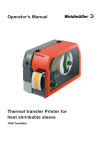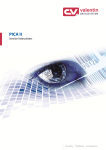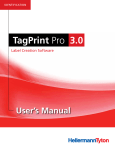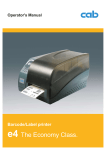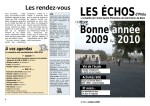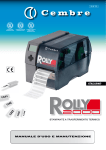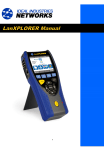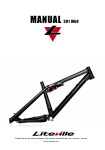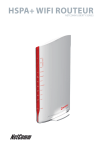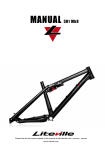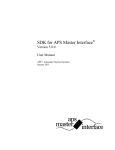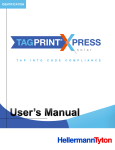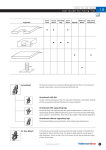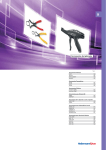Download TTM430 Manual - HellermannTyton
Transcript
Operator's Manual TTM430 Barcode/Label printer 2 Operator's Manual 2 TTM430 Barcode/Label printer Trademark Centronics® is a registered trademark of the Data Computer Corporation. Microsoft® is a registered trademark of the Microsoft Corporation. Windows 2000®, 2003®, XP® are registered trademarks of the Microsoft Corporation. TrueTypeTM is a registered trademark of Apple Computer, Inc. HellermannTyton Corporate Headquarters North America HellermannTyton Canada HellermannTyton Mexico 7930 N. Faulkner Rd, PO Box 245017 205 Industrial Parkway North, Unit #4 Anillo Periferico Sur 7980 Edificio 2 - D Milwaukee, WI 53224 Aurora, Ontario L4G 4C4 Canada Parque Industrial Technologico II Phone: (414) 355-1130, (800) 537-1512 Phone: (800) 661-2461 Tlaquepaque, Jalisco, Mexico 45600 Fax: (414) 355-7341, (800) 848-9866 Fax: (800) 390-3904 Phone: 011-52-33-3-133-9880 http://www.hellermann.tyton.com email: [email protected] Fax: 011-52-33-3-133-9861 email: [email protected] TS16949:2002, ISO 9001:2000 & ISO 14001 certified email: [email protected] Contents 3 1 1.1 1.2 1.3 1.4 Introduction ............................................................................................................................................ 4 Instructions ............................................................................................................................................... 4 Intended Use ............................................................................................................................................ 4 Safety Instructions.................................................................................................................................... 4 Environment ............................................................................................................................................. 5 2 2.1 2.2 2.3 2.4 Installation .............................................................................................................................................. 6 Device Overview ...................................................................................................................................... 6 Unpacking and Installing the Device ........................................................................................................ 7 Connecting the Device ............................................................................................................................. 7 Switching on the Device ........................................................................................................................... 7 3 3.1 3.2 3.3 3.4 Control Panel .......................................................................................................................................... 8 Structure of the Control Panel .................................................................................................................. 8 Symbol Displays....................................................................................................................................... 8 Printer States ........................................................................................................................................... 9 Key Functions ........................................................................................................................................ 10 4 4.1 4.2 4.3 4.4 4.5 Loading Material................................................................................................................................... 11 Loading Label Rolls.................................................................................................................................11 Loading Fanfold Labels .......................................................................................................................... 13 Loading Labels for Peel-off Mode .......................................................................................................... 14 Selecting and Positioning Label Sensors ............................................................................................... 15 Loading Transfer Ribbon ........................................................................................................................ 16 5 5.1 5.2 5.3 5.4 Printing Operation................................................................................................................................ 18 Synchronization of the Paper Feed ........................................................................................................ 18 Tear-Off Mode ........................................................................................................................................ 18 Peel-off Mode ......................................................................................................................................... 18 Cutting Mode .......................................................................................................................................... 18 6 6.1 6.2 6.3 6.4 6.5 Cleaning ................................................................................................................................................ 19 Cleaning Information .............................................................................................................................. 19 Cleaning the Print Roller ........................................................................................................................ 19 Cleaning the Printhead........................................................................................................................... 19 Cleaning the Label Sensors ................................................................................................................... 19 Cleaning the Cutter ................................................................................................................................ 20 7 7.1 7.2 7.3 Fault Correction ................................................................................................................................... 21 Types of Errors ....................................................................................................................................... 21 Problem Solution .................................................................................................................................... 21 Error Messages and Fault Correction .................................................................................................... 22 8 8.1 8.2 Licences ................................................................................................................................................ 24 EU Declaration of Conformity................................................................................................................. 24 Other Licences ....................................................................................................................................... 24 9 Index ...................................................................................................................................................... 25 4 1 Introduction 1.1 Instructions Important information and instructions in this documentation are designated as follows: Danger! Draws your attention to an exceptionally grave, impending danger to your health or life. Warning! Indicates a hazardous situation that could lead to injuries or material damage. Attention! Draws attention to possible dangers, material damage or loss of quality. Notice! Gives you tips. They make a working sequence easier or draw attention to important working processes. Environment! Gives you tips on protecting the environment. X Handling instruction Z Reference to section, position, illustration number or document. ¿ Option (accessories, peripheral equipment, special fittings). Zeit 1.2 Information in the display. Intended Use • The device is manufactured in accordance with the current technological status and the recognized safety rules. However, danger to the life and limb of the user or third parties and/or damage to the device and other tangible assets can arise during use. • The device may only be used for its intended purpose and if it is in perfect working order, and it must be used with regard to safety and dangers as stated in the operating manual. • The device printer is intended exclusively for printing suitable materials that have been approved by the manufacturer. Any other use or use going beyond this shall be regarded as improper use. The manufacturer/supplier shall not be liable for damage resulting from unauthorized use; the user shall bear the risk alone. • Usage for the intended purpose also includes complying with the operating manual, including the manufacturer‘s maintenance recommendations and specifications. Notice! The complete documentation is included in the scope of delivery on CD ROM, and can also currently be found in the Internet. 1.3 Safety Instructions • The device is configured for voltages of 100 to 240 V AC. It only has to be plugged into a grounded socket. • Only connect the device to other devices which have a protective low voltage. • Switch off all affected devices (computer, printer, accessories) before connecting or disconnecting. • The device may only be used in a dry environment, do not expose it to moisture (sprays of water, mists, etc.). • If the device is operated with the cover open, ensure that people‘s clothing, hair, jewelry etc. do not come into contact with the exposed rotating parts. • The device or parts of it can become hot while printing. Do not touch during operation, and allow to cool down before changing material and before disassembly. • Perform only those actions described in this operating manual. Work going beyond this may only be performed by trained personnel or service technicians. 4 1 Introduction • Unauthorized interference with electronic modules or their software can cause malfunctions. • Other unauthorized work on or modifications to the device can also endanger operational safety. • Always have service work done in a qualified workshop, where the personnel have the technical knowledge and tools required to do the necessary work. • There are various warning stickers on the device. They draw your attention to dangers. Warning stickers must therefore not be removed, as then you and other people cannot be aware of dangers and may be injured. Danger! Danger to life and limb from power supply. X Do not open the device casing. 1.4 Environment Obsolete devices contain valuable recyclable materials that should be sent for recycling. X Send to suitable collection points, separately from residual waste. The modular construction of the printer enables it to be easily disassembled into its component parts. X Send the parts for recycling. The electronic circuit board of the device is equipped with a lithium battery. X Take old batteries to collection boxes in shops or public waste disposal centers.. 5 6 2 Installation 2.1 Device Overview 6 View A View B Fig. 1 Overview 1 RS-232 serial interface 2 USB 2.0 High Speed Slave interface 3 Two USB master interfaces for keyboard and scanner 4 Ethernet 10/100 Base T interface 5 CompactFlash card slot 6 Power supply socket 7 PC card slot, type II 8 Power switch 9 Cover 10 11 12 13 14 15 16 17 18 19 Roll hub Holder slots Ribbon rewind hub Printhead mounting with printhead Release button of the print module Pressure roller Control panel Graphic display Label outlet in the control panel Navigator pad 2 Installation 2.2 Unpacking and Installing the Device 7 X Lift the label printer out of the carton by the straps. X Check the label printer for any possible transportation damage. X Check that the delivery is complete. Delivery scope: • Label printer • Power cable • Documentation • cablabel Lite on CD-ROM • Documentation on CD-ROM Notice! Please keep the original packaging in case the printer must be returned. Attention! The device and printing materials will be damaged by moisture and wetness. X Set up label printers only in dry locations protected from splash water. X Place the printer on a flat surface. 2.3 Connecting the Device The standard available interfaces and connectors are shown in figure 1, view A. 2.3.1 Connecting to the Power Supply The printer is equipped with a wide area network unit. The device can be operated with a supply voltage of 230 V~/50 Hz or 115 V~/60 Hz without adjustment. 1. Check that the device is switched off. 2. Plug the power cable into the power connection socket (6). 3. Plug the power cable into a grounded socket. 2.3.2 Connecting to a Computer or Computer Network Attention! Inadequate or no grounding can cause malfunctions during operations. Ensure that all computers and cables connected to the label printer are grounded. X Connect the label printer to a computer or network by a suitable cable. X For details of the configuration of the individual interfaces Z the Configuration Manual. 2.4 Switching on the Device When all connections have been made: X Switch the printer on at the power switch (8). The printer performs a system test, and then shows the system status ready in the display (17). If an error occurs during the system test, the symbol and type of error are displayed. 8 3 Control Panel 3.1 Structure of the Control Panel 8 The user can control the operation of the printer with the control panel, for example: • Issuing, interrupting, continuing and canceling print jobs, • Setting printing parameters, e.g. heat level of the printhead, print speed, interface configuration, language and time of day (Z Configuration Manual), • Start the test functions (Z Configuration Manual and Z Service Manual), • Control stand-alone operation with a memory module (Z Configuration Manual), • Update the firmware (Z Configuration Manual). Many functions and settings can also be controlled by software applications or by direct programming with a computer using the printer’s own commands. Z Configuration Manual for details. Settings made on the control panel make the basic settings of the label printer. Notice! It is advantageous, whenever possible, to make adaptations to various print jobs in the software. Fig. 2 Control Panel The control panel consists of a graphic display (1) and the navigator pad (2) with five integrated keys. The graphic display indicates the current status of the printer and the print job, indicates faults and shows the printer settings in the menu. 3.2 Symbol Displays The symbols shown in the following table may appear in the status line of the display, depending on the printer configuration. They enable the current printer status to be seen quickly. For the configuration of the status line Z the Configuration Manual. Symbol Table 1 Description Symbol Description Symbol Description Clock time Temperature of the printhead Input buffer Date Debug window for abc programs Access to memory card Ribbon reserve status Control of the lower display line is handed over to an abc program Printer receiving data WLAN field strength PPP credit Ethernet status User memory Symbol displays 3 Control Panel 3.3 Printer States 9 State Display Description Ready Ready The printer is in the ready state and can receive data. and configured symbol displays, such as time Printing label and date Printing label and the number of the printed label in the print job. The printer is currently processing an active print job. Data can be transmitted for a new print job. The new print job will start when the previous one has finished. Pause Pause and the symbol Correctable error The printing process has been interrupted by the operator. An error has occurred that can be rectified by the operator without interrupting the print job. and the type of error and the number of labels still to be printed. Irrecoverable error The print job can be continued after the error has been rectified. An error has occurred that cannot be rectified without interrupting the print job. and the type of error and the number of labels still to be printed. Critical error An error occurs during the system test. and the type of error X Switch the printer off and then on again at the power switch or X Press cancel key. Call Service if the fault occurs persistently. If the printer is not used for a lengthy period, it automatically switches to power save mode. Power Save Mode and the key lighting is switched off Table 2 Printer states X To exit power save mode: Press any key on the navigator pad. 10 3 Control Panel 3.4 Key Functions 10 The key functions depend on the current printer state: - Active functions: Labels and symbols on the navigator pad keys light up. - Active functions light up white in print mode (e. g. menu or feed). - Active functions light up orange in the offline menu (arrows, key ). • Key Display State Function menu lights Ready Ready To the offline menu feed lights Ready Ready Feeds a blank label pause lights Ready Ready After the end of a print job, reprint the last label Printing label Printing label Interrupt print job, printer goes into "Pause" state Pause Pause Continue the print job, printer goes into "Printing label" state Correctable error Continue the print job after rectifying the error, printer goes into "Printing label" state Ready Delete internal memory, the last label can no longer be reprinted. flashes cancel lights Ready Printing label Printing label Short press J Pause Longer press J cancels the current print job and deletes all print jobs Pause Correctable error Table 3 Key flashes Irrecoverable error lights Error cancels the current print job Call Help - Concise information for rectifying the fault will be displayed Key functions in the print mode Menu Parameter setting Parameter choice Numeric value Return from a submenu - Increase of the number at the cursor position Jump into a submenu - Decrease of the number at the cursor position Menu option to the left Sheets to the left Cursor shift to the left Menu option to the right Sheets to the right Cursor shift to the right Start of a selected menu option Confirmation of the selected value Pressing 2 s: Leaving the offline menu Pressing 2 s: Abort without changing the value Table 4 Key functions in the offline menu 4 Loading Material 4.1 Loading Label Rolls 4.1.1 Adapting the Roll Hub Label rolls are supplied with different diameters. The roll hub can hold label rolls with a core diameter of 38 - 75 mm, or 76 mm with the detachable adapters fitted. Fig. 3 Roll hub with and without adapter Dismounting the adapter X Open the cover and remove the roll hub (10 - fig. 1) from the printer. X Remove the edge stop (3), Z item 4.1.2), press the adapter (2) in at the three pressure points (1), as shown in the figure, and remove it. Mounting the adapter Push the adapter (2) on until it slots into place. 11 12 4 Loading Material 4.1.2 Loading Labels The method of loading label rolls applies to both thermal paper labels and labels that are printed by means of a transfer ribbon. Fig. 4 Roll holder and path of the label stock 1. Open the cover and hinge down the control panel. 2. Take the roll hub (10 - fig.1) out of the holder slots (11 - fig.1) in the printer. 3. Press down the lever (3) on the edge stop 2 (2) and pull the edge stop off from the label core (4). 4. If necessary, mount or dismount the adapter, Z item 4.1.1. Slide the label roll over the label core (4) and place it against the edge stop 1 (1) so that it is guided by the adapter (5) and the flange of the edge stop. In so doing, ensure that the labels on the unwound strip are facing up irrespective of the wind direction. 5. Remount the edge stop 2 (2) on the label core (4) and, with the lever pressed (3), slide it against the label roll. In so doing, the label roll is automatically set in the center line by the edge stops. Place both edge stops against the label roll, and release the lever (3). 6. Place the roll hub back into the holder slots on the printer. Ensure that the rounded surfaces of the edge stops are facing forward, Z fig. 1. 7. Press the release button (14 - fig.1) and hinge the print module up. 8. Feed the label stock forwards under the deflector (6) and over the print roller (9) until it projects about 15 cm out of the printer. 9. Move the label guides (8) apart with the setting wheel (7) until the labels can pass between them. Press the strip label down, and move the label guides (8) back up against the edges of the label. 10. Hinge the print module down and press evenly on the two marked surfaces so that the unit snaps in on both sides. 11. For peel-off mode Z item 4.3. For tear-off and cutting mode: Feed the label stock out through the label outlet in the control panel (18 - fig.1). Hinge up the control panel and close the cover. 12 4 Loading Material 4.2 Loading Fanfold Labels The method of loading fanfold labels applies to both thermal paper labels and labels that are printed by means of a transfer ribbon. View A Fig. 5 Loading fanfold labels 1. Stack the fan-folded labels (1) behind the printer. Ensure that the labels on the strip are facing upwards. 2. Open the cover and hinge down the control panel (5). 3. Feed the fan-folded labels (1) below the cover. 4. Adapting the roll hub (2) to the label width: Take the roll hub (2) out of the holder slots (4) in the printer. Remove the adapter from the roll hub, Z item 4.1.1. Push down the lever (3 - fig. 4) and justify the edge stops 1 and 2 (2 - fig. 4) centrically on label width. 5. Place the roll hub back into the holder slots (4) on the printer. Ensure that the rounded surfaces of the edge stops are facing forward. 6. Feed the labels over the roll hub (2). 7. Press the release button (6) and hinge the print module up. 8. Feed the fanfold labels forwards under the deflector, (6 - fig. 4), and over the print roller, (9 - fig. 4), until it projects about 15 cm out of the printer. 9. Move the label guides (8 - fig. 4) outward with the setting wheel (7 - fig. 4) until the labels can pass between them. Press the strip label down with the hand, and move the label guides (8 - fig. 4) back up against the edges of the label. 10. Hinge the print module down and press evenly on the two marked surfaces (3) so that the unit snaps in on both sides. 11. For peel-off mode Z item 4.3. For tear-off and cutting mode: Feed the label stock out through the label outlet in the control panel (18 - fig. 1). Hinge up the control panel (5) and close the cover. 13 14 4 Loading Material 4.3 Loading Labels for Peel-off Mode Notice! Place the printer in such a position that the liner can run down without hindrance. A label jam can cause malfunctions in printing operations. Fig. 6 Setting up the Peel-off Mode 1. Loading the label stock Z item 4.1 or item 4.2, steps 1 to 10. 2. In the control panel, release the pressure roller (3) from the parking position (2). To do this, press on the metal pins at each end of the roller so that the roller is pressed out of the parking position (2) and into the working position (1) by the built-in springs. 3. Remove the labels (5) from about the first 15 cm of the label stock. 4. Feed the media (4) out between the control panel and the printer. 5. Hinge up the control panel and close the cover. 6. Carry out a synchronization Z item 5.1. 14 4 Loading Material 4.4 Selecting and Positioning Label Sensors 4.4.1 Gap Sensors Fig. 7 Selecting the gap sensor The printer has two gap sensors (1, 2) to detect the start of a label and the end of the material, which can be used alternatively. The detectors (1a, 2a) are located in the transport module, the emitters (1b, 2b) in the print module. The gap sensor (2) is used as default. This is suitable for use with single and multi-lane labels with an odd number of lanes. When using multi-lane labels with an even number of lanes, e.g. two or four lanes, one has to switch manually to the gap sensor (1). 1. Open the cover and hinge down the control panel. Press the release button and hinge the print module up. 2. Set the switch (3) as required: for gap sensor (1) - move switch (3) to left-hand position, for gap sensor (2) - move switch (3) to right-hand position (default). 3. Slot in the print module by pressing the marked surfaces on both sides, hinge up the control panel and close the cover. This switch cannot be made by software. 4.4.2 Reflex Sensor The reflex sensor (1) can detect marks on the back of the label stock. Move the sensor transversely to the transport direction with the slide (2) to adapt to the position of the reflective marks: 1. Determine the distance of the reflective marks from the center of the material. 2. Move the slide (2) to the desired position with a pointed tool. The distance of the sensor from the center is shown on the scale (3). Fig. 8 Positioning the Reflex Sensor 15 16 4 Loading Material 4.5 Loading Transfer Ribbon Notice! Do not insert a transfer ribbon for direct thermal printing. Attention! When inserting the transfer ribbon ensure that the coated side faces the labels, as otherwise the printhead can become soiled. Fig. 9 Loading Transfer Ribbon 16 4 Loading Material 1. Open the cover and hinge down the control panel. 2. Press the release button and hinge the print module up. 3. Press the ribbon supply hub (2) to the right until there is perceptible resistance, pull it to the left out of the guide slot (1) and remove it. 4. Set the width of the ribbon roll on the ribbon supply hub (2). For that purpose press the lever (4) and move it sidewards. The set roll width is shown on the scale (3) of the ribbon supply hub (2). 5. Slide the ribbon roll onto the ribbon supply hub (2) until the lever (4). Ensure that the coated side of the transfer ribbon (7) is facing to the label stock. 6. To insert the ribbon supply hub (2) again press the rectangular end (5) of the hub against the spring in the righthand holder, and slide the left-hand end into the guide slot (1) as far as it will go. 7. Hinge the print module down (do not slot in). 8. Insert an empty roll (10) for the used transfer ribbon onto the ribbon rewind hub (9) and set the width for the empty roll similarly to steps 3 to 5. 9. To insert the transfer ribbon rewinding unit (9) again press the rectangular end (5) of the hub against the spring in the right-hand holder, and slide the left-hand end into the guide slot (6) as far as it will go. 10. Feed the transfer ribbon (7) over the printhead to the ribbon rewind hub (9), and attach the ribbon to the empty roll with adhesive tape. Ensure that it is wound as shown in the figure and ensure that the ribbon is not twisted. 11. Turn the tension wheel (11) in the winding direction until the ribbon is tightly wound on the roll. 12. Slot in the print module by pressing the marked surfaces (8) on both sides, hinge up the control panel and close the cover. 17 18 5 Printing Operation Attention! Printhead damage caused by improper handling! X Do not touch the underside of the printhead with the fingers or sharp objects. X Ensure that the labels are clean. X Ensure that the label surfaces are smooth. Rough labels act like emery paper and reduce the service life of the printhead. Print with the lowest possible printhead temperature. The printer is ready for operation when all connections have been made and labels and, if applicable, the transfer ribbon have been loaded. 5.1 Synchronization of the Paper Feed After the label stock has been inserted, for peel-off or cutting mode a synchronization of the paper feed is required. That way the first label, which is detected by the label sensor, will be transported to the print position and all labels in front will be fed out of the printer. So the synchronization avoids, that blank labels are peeled-off together with the first printed label or that the first cut label would be too long. Both effects can cause useless first labels. X Press the feed key to start the synchronization. X Remove the blank labels peeled-off or cut during the synchronization. 5.2 Tear-Off Mode After printing, the strip label is detached by hand. The label printer is equipped with a tear bar for this purpose. Optionally, the strip of labels can be wound up externally. Loading label stock Z item 4.1 or Z item 4.2. 5.3 Cutting Mode The cutting mode is available for the printer types TTM430C. The labels or continuous material is cut-off automatically. The relevant cutting position is preferably set in the software. Loading label stock Z item 4.1 or Z item 4.2. Notice! Cutting mode must be activated in the software. This is done with the "C command" in the direct programming, Z Programming Manual. 18 6 Cleaning 6.1 Cleaning Information Danger! Danger to life and limb from electric shock! X Disconnect the printer from the electricity supply before starting any maintenance work. The label printer requires very little maintenance. It is important to clean the thermal printhead regularly. This guarantees a consistently good printed image and plays a major part in preventing premature wear of the printhead. Otherwise, the maintenance is limited to occasional cleaning of the device. Attention! The printer can be damaged by aggressive cleansers. Do not use abrasive cleaners or solvents for cleaning the external surfaces or modules. X Remove dust and paper fluff from the print area with a soft brush or vacuum cleaner. X The cover of the printer can be cleaned with a standard cleanser. 6.2 Cleaning the Print Roller Accumulations of dirt on the print roller may impair the media transport and the print quality. In the case of slight soiling, it is not necessary to remove the print roller. The roller can be turned step by step by hand. Use a soft cloth and roller cleaner for cleaning. 6.3 Cleaning the Printhead Dirt can collect on the printhead during printing which affects the printed image, for example by causing different contrasts or longitudinal stripes. Attention! Printhead damage! Do not use sharp objects for cleaning the printhead. Do not touch the protective glass layer of the printhead. Attention! Risk of injury from the hot printhead line. Ensure that the printhead has cooled down before starting cleaning. X Clean the printhead with a cleaning pen or with a cotton swab soaked in pure alcohol. X Allow the printhead to dry for two or three minutes. 6.4 Cleaning the Label Sensors Attention! Do not damage the light barrier! Do not use sharp objects or solvents for cleaning the light barrier. The label sensors can be soiled by paper dust. This can impair the detection of the start of the label or the print marks. X Clean the label sensors with a brush, or with a cotton swab dipped in isopropyl alcohol. 19 20 6 Cleaning 6.5 Cleaning the Cutter Attention! When cutting through the label material remains of adhesive may accumulate on the blades. If operating in backfeed mode, such remains of adhesive may be deposited on the drive roller as well. X Both, the drive roller and the cutter blades, must be cleaned often. Fig. 10 Cleaning the cutter 1. Turn the control panel (1) down. 2. Unlock the cutting unit (3) at the both plastic latches (2) and lift it. 3. Turn the screw (4) clockwise using a 2.5mm Allen key and that way swivel the clamp (6) with the lower blade (7) away from the upper blade (5). Warning! Risk of cuts and bruisings! X Do not touch the blade edges with bare hands. X Keep the hands away from the swivel range of the lower blade. 4. Remove particles of dust and paper with a soft brush or a vacuum. 5. Remove remains of adhesive with isopropyl alcohol. 6. Remount in reverse order. 20 7 Fault Correction 7.1 Types of Errors 21 The diagnostic system indicates on the screen if an error has occurred. The printer is set into one of the three possible error states according to the type of error. State Display Correctable error Key Remark pause flashes Z item 3.5 cancel lights Irrecoverable error cancel flashes Z item 3.5 Critical fault - Z item 3.5 Table 5 7.2 Error states Problem Solution Problem Cause Remedy Transfer ribbon creases Transfer ribbon too wide Use a transfer ribbon slightly wider than the width of label. Print image has smears or voids Printhead is dirty Clean the printhead Z item 6.2. Temperature too high Decrease temperature via software. Unsuitable combination of labels and transfer ribbon Use different type of ribbon. Printer does not stop after transfer ribbon runs out Thermal printing is chosen in the software Change to thermal transfer printing. Printer prints a sequence of characters instead of the label format Printer is in ASCII dump mode Cancel the ASCII dump mode. Printer transports label media, but transfer ribbon does not move Transfer ribbon incorrectly inserted. Check and, if necessary, correct the transfer ribbon web and the orientation of the label side. Unsuitable combination of labels and transfer ribbon Use different type of ribbon. Printer only prints each second label Setting of the size in the software is too large. Change the size in the software. Vertical white lines in the print image Printhead is dirty Clean the printhead Z item 6.2. Printhead is defective (failure of heat elements) Change the printhead. Horizontal white lines in the print image Printer is used with the backfeed > smart in the cut or peel-off mode Set the backfeed > always in the setup. Z Configuration Manual. Print image is irregular, one side is lighter Printhead is dirty Clean the printhead Z item 6.2. Table 6 Problem solution 22 7 Fault Correction 7.3 Error Messages and Fault Correction 22 Error messages Cause Remedy ADC malfunction Hardware error Switch the printer off and then on. If error recurs call service. Barcode error Invalid barcode content, e.g. alphanumeric characters in a numerical barcode Correct the barcode content. Barcode too big The barcode is too big for the allocated area of the label Reduce the size of the barcode or move it. Battery low Battery of the PC card is flat Replace battery in the PC card. Buffer overflow The input buffer memory is full and the computer is still transmitting data. Use data transmission via protocol (preferably RTS/CTS). Card full No more data can be stored on the memory Replace card. card Cutter blocked Cutter cannot return into its home position and stays in an undefined position Switch off the printer. Remove material. Switch on the printer. Restart print job. Change material No cutter function Switch the printer off and then on. If error recurs call service. Cutter jammed The cutter is unable to cut the labels but is able to return into its home position Press the cancel key. Change material. Device not conn. Programming addresses a non-existent device Either connect this device or correct the programming. File not found Requested file is not on the card Check the contents of the card. Font not found Error with the selected download font Cancel current print job, change font. FPGA malfunction Hardware error Switch the printer off and then on. If error recurs call service. Head error Hardware error Switch the printer off and then on. If error recurs replace printhead. Head open Printhead not locked Lock printhead. Head too hot Printhead is overheated After pausing the print job will be continued automatically. If the fault recurs repeatedly, reduce the heat level or the print speed via software. Invalid setup Error in the configuration memory Reconfigure printer. If error recurs call service. Memory overflow Current print job contains too much information, e.g. selected font, large graphics Cancel current print job. Reduce amount of data to be printed. Name exists Duplicate usage of field name in the direct programming Correct programming No DHCP server The printer is configured for DHCP, but there is no DHCP server, or the DHCP server is not currently available. Switch off DHCP in the configuration, and assign a fixed IP address. Please contact your network administrator. No label found There are labels missing on the label material Press pause key repeatedly until printer recognizes the next label on the material. The label format as set in the software does Cancel current print job. not correspond with the real label format Change the label format set in the software. Restart print job. No label size Printer is loaded with continuous paper, but the software is set on labels Cancel current print job. Change the label format set in the software. Restart the print job. The size of the label is not defined in the programming. Check programming. 7 Fault Correction 23 Error messages Cause Remedy No Link No network link Check network cable and connector. Please contact your network administrator. No record found Refers to the optional memory card; database access error Check programming and card contents. No SMTP server The printer is configured for SMTP, but there is no SMTP server, or the SMTP server is not currently available. Switch off SMTP in the configuration. Caution! Then a warning cannot be sent by e-mail (EAlert). Please contact your network administrator. No Timeserver Timeserver is selected in the configuration, but there is no Timeserver, or the Timeserver is not currently available. Switch off Timeserver in the configuration. Please contact your network administrator. Out of paper Out of label roll Load label rolls Z item 4.1 or load fanfold labels Z item 4.2. Error in the paper feed Check paper feed. Out of ribbon Out of transfer ribbon Insert new transfer ribbon. Transfer ribbon melted during printing Cancel current print job. Change the heat level via software. Clean printhead Z item 6.2. Load transfer ribbon Z item 4.6. Restart print job. The printer is loaded with thermal labels, but the software is set to transfer printing Cancel current print job. Set software to direct thermal printing. Restart print job Protocol error Printer has received an unknown or invalid command from the computer. Press the pause key to skip the command or press the cancel key to cancel the print job. Read error Read error when reading from the memory card Check data of the card. Backup data, reformat card. Structural err. Error in the file list of the memory card, data Format memory card. access is uncertain. Unknown card Card not formatted, Type of card not supported Format card, use different type of card. USB error Device stalled A USB device has been detected, but it is not working. Do not use the USB device. USB error Too much current The USB device consumes too much current. Do not use the USB device. USB error Unknown device Failure to detect USB device Do not use the USB device. Voltage error Hardware error Switch the printer off and then on. If error recurs call service. It is shown which voltage has failed. Please note. Write error Hardware error Repeat the write process, reformat card. Write protected PC card write protection is activated. Deactivate the write protection. Wrong revision Error when updating the firmware. Firmware not compatible with the hardware version Load the compatible firmware. Table 7 Error Messages and Fault Correction Index 24 24 A L T Adapter dismounting ................................ 11 mounting ..................................... 11 Label outlet in the control panel..........6 Tear-off mode ...................................18 Label rolls loading ........................................ 11 Label sensor cleaning ......................................19 positioning ...................................15 selecting ......................................15 Licences other ............................................24 Transfer ribbon loading ........................................16 winding direction .........................17 C Cleaning .....................................19, 20 cutter ...........................................20 label sensors ...............................19 printhead .....................................19 print roller ....................................19 Cleaning information.........................19 CompactFlash card slot ......................6 Connecting .........................................7 Control panel ..................................6, 8 N Navigatorpad ..................................6, 8 P Cover ..................................................6 PC card slot ........................................6 Cutting mode ....................................18 D Peel-off mode ...................................18 loading labels ..............................14 Power save mode ...............................9 Device overview .................................6 Power supply socket...........................6 E Power switch ......................................6 Pressure roller ....................................6 Environment ...................................4, 5 Errors messages ...................................22 types ...........................................21 F Fanfold labels loading ........................................13 G Gap sensor positioning ...................................15 selecting ......................................15 Graphic display ...............................6, 8 Printer state correctable error ...........................9 critical fault ....................................9 irrecoverable error ........................9 pause ............................................9 printing label .................................9 ready .............................................9 Printer states ......................................9 Printhead ............................................6 cleaning ......................................19 damage .......................................18 Printhead mounting ............................6 H Print roller cleaning ......................................19 Problem solution ...............................21 Holder slots.........................................6 R I Ready for operation ..........................18 Important information..........................4 Reflexsensor positioning ...................................15 Reinigen Messer ........................................20 Release button of the print module.....6 Installing .............................................7 Intended use .......................................4 Interface ethernet .........................................6 serial .............................................6 USB ..............................................6 K Ribbon rewind hub..............................6 Roll hub ..............................................6 adapting ...................................... 11 S Key cancel .........................................10 feed .............................................10 menu ...........................................10 pause ..........................................10 Key functions ....................................10 offline menu ................................10 print mode ...................................10 Safety instructions ..............................4 Scope of delivery ................................7 Service work .......................................5 Switching on .......................................7 Symbol displays..................................8 Synchronization of the paper feed ....18 U Unpacking...........................................7 V Voltage................................................4 W Warning stickers .................................5 25 26 26



























